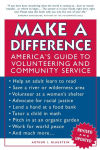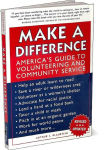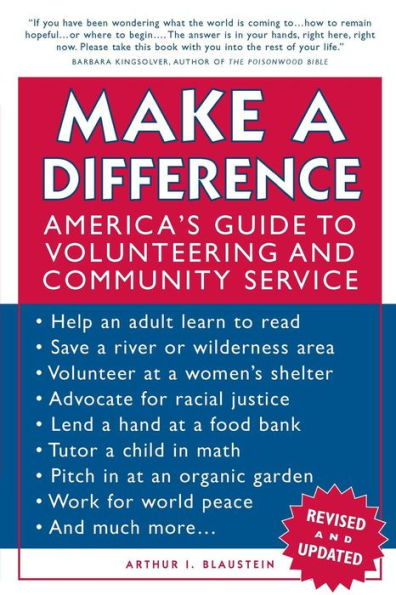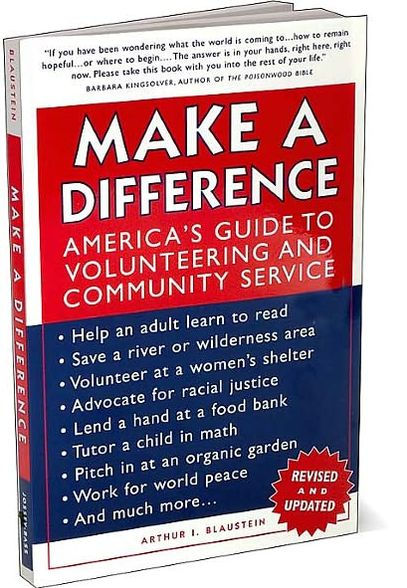Read an Excerpt
Make a Difference
Your Guide to Volunteering and Community Service, Revised
By Arthur I. Blaustein
John Wiley & Sons
Copyright © 2003
Arthur I. Blaustein
All right reserved.
ISBN: 0-7879-6804-8
Chapter One
The Challenge
of Community Service
The traditions of community service and citizen participation have been at
the heart of American civic culture since before the nation was founded.
Whether through town hall meetings, the local school board, a political
party, a hospital auxiliary, or one of our innumerable other national and
local organizations, Americans have felt and acted on the need to give
something back to their communities. Since the events of September 11,
2001, and in the midst of our nation's two-year economic decline, this
need has become more urgent as Americans have become more introspective
and more patriotic, and more anxious. Patriotism and anxiety have
taken many different forms, but one thing is clear: our concern for our
country, our communities, our families, and our neighbors has become
more acute and our need to contribute more urgent.
With firefighters, police officers, and rescue teams leading the way after
September 11, many thousands of ordinary citizens-ironworkers, teachers,
public healthclinicians, professionals, businesspeople, and school-children-volunteered
to go to Ground Zero or offered their support from
a distance. Everything from blankets to blood, peanut butter to poetry,
arrived in New York City by the bale, the gallon, the barrel, and the ream.
Americans didn't wait until January 1, 2002, to make resolutions; in mid-September,
many resolved to be more caring and giving.
Make a Difference is here to help harness this outpouring of compassion,
energy, concern, and patriotism in creative and useful ways. If
you've decided to make a difference because of the events of September
11 or if volunteering is one of those things you've been meaning to do all
along but just haven't gotten around to, or if you're just curious about
what's out there, this book can help you take the next step. It is designed
to help you decide that you can make a contribution to the well-being of
your community. It will help to answer the why, the how, the what, and
the when. Why is community service important? How can you get in
touch with a group that promotes the values and goals that you believe
in? What specific volunteer activities match up with your skills and experiences?
When is a good time to volunteer?
Each of the organizations profiled in this book has been selected
because of its commitment to educational, social, economic, environmental,
and community development goals. Some have been in existence for
many decades; others are fairly new. Most are national organizations, and
some are local prototypes, but all have a solid track record of delivering
services that are useful and meaningful. Before you select an organization
to volunteer for, ask yourself a few questions:
How much time do you want to serve?
What kind of service fits your personality?
What neighborhood and community do you want to work in?
Which target population do you want to work with?
What skills do you have to offer?
What would you like to gain from the experience?
If, for example, you're over seventeen, can commit a full year, and
would like leadership training, some income, and a stipend, you should
seriously consider AmeriCorps, where you'll be able to work as a teacher or
with environmental, health care, or public safety projects. If you want to
commit a year and you're over eighteen and want to work on environmental,
art, or music projects or in community development, you should think
about Volunteers in Service to America (VISTA). If you have only a week-end
or one day a week, you like working with your hands, and you want to
be outdoors, Habitat for Humanity, which builds housing for low-income
residents in your community, will probably be perfect. If you only have a
few hours a week and enjoy children, consider mentoring or tutoring with
an educational group. It might take some reflection and research on your
part, but there is a fulfilling opportunity for everyone.
Historically, our greatest strength as a nation has been to be there for
one another. Citizen participation is the lifeblood of democracy. As
Thomas Paine put it, "The highest calling of every individual in a democratic
society is that of citizen!" Accidents of nature and abstract notions of
improvement do not make our communities better or healthier places in
which to live and work. They get better because people like you decide
that they want to make a difference.
Volunteering is not a conservative or liberal, Democratic or Republican
issue; caring and compassion simply help to define us as being human.
Unfortunately, opportunistic radio talk show hosts and reactionary politicians
have spread two false myths about community service. The first is
the notion that only inner-city minorities benefit from volunteer efforts.
Here's a story about that myth, told to me by a friend who was in VISTA.
He was helping local groups organize fuel cooperatives many years ago in
small towns in Maine. That winter was unusually cold, and the price of
home heating had skyrocketed, placing an enormous financial burden on
most families in the state, which had a low per capita income. He was
invited to make a presentation to about two hundred residents in the
town's church. After the talk, one of the "happy guy" television reporters
from Portland baited a farmer, asking, "What do you think of this outside
agitation?"
The farmer, who was about seventy-five, paused for a moment and, with
an edge of flint in his voice, said, "You know, I'm a fourth-generation
Republican Yankee-just like my father, my grandfather, and my great-grandfather-but
if I've learned anything, it's that there are two kinds of
politics and economics in America. The first kind is what I see on television
and what politicians tell me when they want my vote. The other kind
is what me and my friends talk about over doughnuts and coffee. And
that's what this young fellow was talking about tonight-and he made a
lot of sense to me. I'm joining the co-op."
Over 67 percent of America's poor are white, like this farmer, and white
families with children are the fastest-growing homeless population. The
myth that social programs serve only inner-city minorities stigmatizes volunteer
social programs, which are, in fact, color-blind.
The second myth is that the vast majority of individuals who volunteer
for community service are naive, idealistic do-gooders. Here's a story about
that myth. It happened to me in a bookstore in northern California. Eight
years ago, I was a technical adviser to the producers of a public television
series, "The New War on Poverty." There was a companion book to the
series, and because I had been one of the contributing editors, the publisher
asked me to give readings. This particular evening, I showed film
clips from the series and spoke about the importance of several War on
Poverty programs, including Head Start, the Job Corps, VISTA, Legal Services,
and Upward Bound.
While I was signing books after the reading, a woman in her mid-twenties
who looked like a quintessential California Valley Girl-blonde hair,
blue eyes-approached me with tears in her eyes. I asked if I had said anything
that offended her. She replied that I had not and told me she was
nonpolitical, conservative, and in her last year of law school. She had been
a political science major at college but knew nothing about the history of
the War on Poverty. She said she was ashamed because, despite having
benefited personally from two of the programs I had spoken about-Head
Start and Upward Bound-she had never before felt a responsibility to give
back to her community and to ensure that these programs would be continued
so that others could have the same opportunities she had.
Like this woman, the vast majority of volunteers I've worked with are
not idealistic; they are serious realists. They are only too aware that as a
nation, we cannot squander our human and natural resources.
Community service not only exposes the sterility of this kind of idealism-versus-realism
debate, but helps individuals to integrate their own idealism
and realism in a healthy way. An idealist without a healthy dose of
realism tends to become a naive romantic. A realist without ideals tends to
become a cynic. Community service helps you put your ideals to work in a
realistic setting. It creates a dynamic tension that gives you a coherent and
comprehensive approach to complex problems. I've seen it happen time
and again with my students and with VISTA and AmeriCorps volunteers.
Dr. Margaret Mead, one of my teachers in graduate school at Columbia,
wrote that a truly healthy person is a thinking, feeling, acting person.
That's what serving helps us to achieve.
The talk show hosts and politicians who push these myths are scape-goating
and attacking the most vulnerable segments of our society. They
are adept at moralizing over the problems of the homeless and the hungry,
the unemployed and the underemployed, drug users and the mentally ill,
and over such issues as infant mortality, child and spousal abuse, and disrupted
families. But they have neither the heart nor the will for rigorous
thought and the work of finding cures, or even relieving some of the suffering
or symptoms. Just as military service and patriotism should not be
politicized, neither should community service.
Nearly forty years ago, when President John F. Kennedy launched the
Peace Corps, he made this oft-quoted suggestion: "Ask not what your
country can do for you; ask what you can do for your country." After
thirty years of firsthand experience with hundreds of volunteers, I would
make a follow-up suggestion: "Ask not what you can do for your community
and the people you serve, but what they can do for you." Community
service is very much a two-way street. It is about giving and receiving, and
the receiving can be nourishing for the heart and mind. The very act of
serving taps into a wellspring of empathy and generosity that is both personally
gratifying and energizing. Again and again, former volunteers
describe their experiences with words like these: adventure, growth, human
connection, exciting, spiritual, maturing, learning, and enjoyable.
I saw this in action three years ago when I decided to give the students
in each of my classes, mostly university seniors, the choice between a
midsemester exam or sixteen hours of community service. The students
unanimously chose service, though most of them didn't know what was in
store for them. They had a choice of about forty different activities organized
by the Public Service Center at the University of California, Berkeley.
Here's what one student wrote about this experience:
Before I started volunteering, I had very different expectations
about the [after-school] program. I thought it would be very
sports-oriented with little academic emphasis. Luckily, my
expectations proved false. The program-for fourth and fifth-graders
at the Thousand Oaks/Franklin Elementary School-has
a set schedule for each grade. The students rotate between free
play, sports, library study time, circle time, and arts and crafts.
It was in the library that I saw how truly behind these children
are in mathematics, reading, and grammar. In addition, I
never expected to see the immense poverty that these children
experience or to be so emotionally affected by it. Last week, I
learned that one of my favorite children is homeless. It seems so
silly to be reprimanding him for not doing his homework and
not putting the effort at school. This seems so trivial compared
to the real-life horrors that he must experience. Although I had
my expectations, never did I anticipate the emotional attachment
that I now share with these children. I find myself yearning
to become a teacher, which was a career I never thought
about before this program. I know that as these children grow,
they will probably forget about me; but I know I will never forget
them. I have truly changed and matured as a result of them.
A second student wrote:
Before I started tutoring I was really scared, because I didn't
know what tutors did in junior high schools. I was afraid of not
being able to explain things so that the kids could understand. I
thought I might also lose patience quickly with kids who were
slower in understanding and for whom I would have to repeatedly
state the same thing. I was concerned that the kids would
resent me or not respect me because I wasn't the teacher and
was closer to their age. And finally, I thought they wouldn't like
me; the first day I even had trouble introducing myself because
of this initial uncertainty.
Contrary to these preliminary fears, however, tutoring at
Willard has been a life-changing experience for me. I've found that
I have more patience working with kids than I've ever had in
any other area of my life. I work hard to come up with lots of
examples when the kids I'm working with don't understand. We
relate well to one another because I'm close to their age, yet
they respect me because I go to Cal and they know that I'm
there to help them. It's been the joy of my semester to work
with these students, who I really appreciate.
These comments were typical of the experiences of nearly all eighty students.
Their testimony is consistent with the more formal academic
research and evaluations, which tell us that service-learning clearly
enriches and enhances the individual volunteer in multiple ways. And the
same things happened to me during my own community service thirty-five
years ago, when I taught in Harlem during the early years of the War
on Poverty and VISTA.
My students now, and I back then, confronted the complexities of the
everyday worlds of individuals and communities quite different from our
own. We were forced to deal with difficult social and economic realities. It
was an eye-opener to learn about the inequities and injustices of our society,
to see firsthand the painful struggles of children who did not have the
educational, social, or economic opportunities that we took for granted.
This experience was humbling, and it broke down my insularity, for which
I'm truly grateful. Dr. Margaret Mead called this "heart-learning."
Community service also taught me an important lesson about our society:
ethical values and healthy communities are not inherited; they are
either recreated through action by each generation, or they are not. That is
what makes AmeriCorps, VISTA, and other forms of community service
unique and valuable. They help us to regenerate our best values and principles
as individuals and as a society. From Plato to the present, civic virtue
has been at the core of civilized behavior.
Continues...
Excerpted from Make a Difference
by Arthur I. Blaustein
Copyright © 2003 by Arthur I. Blaustein.
Excerpted by permission.
All rights reserved. No part of this excerpt may be reproduced or reprinted without permission in writing from the publisher.
Excerpts are provided by Dial-A-Book Inc. solely for the personal use of visitors to this web site.






